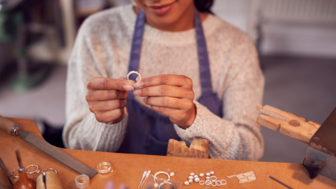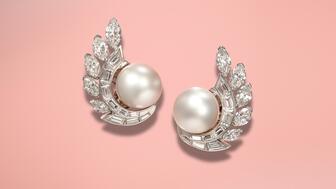Interior designer Athena Calderone looked to decor from the 1920s and 1930s when crafting her first fine jewelry collection.
What Does Transparency Mean in 2019?
It’s central to growing your business, and it’s not just about material provenance.
There are a handful of topics right now in the jewelry industry that come up again and again—sustainability, social media and omnichannel retail, to name a few—and rightly so, because they signal monumental changes in the way all sectors of the industry do business.
Transparency is one of these hot topics that I hear a great deal about, but I was surprised to get a totally different take on the issue at a recent educational panel at JCK Las Vegas.
Moderated by Ben Smithee of The Smithee Group, the panelists of “JCK Next Generation” illuminated how empowering transparency can be for a company when approached in a multi-faceted way.
“Some of us think if we don’t know provenance for every single element that we can’t participate in being transparent with our customers—that’s not at all true.”— Michelle Adorjan Chila, Tacori
“Don’t be intimidated by it,” said Michelle Adorjan Chila, senior vice president of marketing and public relations at Tacori.
“Some of us think if we don’t know provenance for every single element that we can’t participate in being transparent with our customers—that’s not at all true.”
For Tacori, Chila explained, which is handmade in California, the brand’s current mission is to illuminate what it already offers—“bespoke, made-to-measure jewelry”—to consumers.
“What we’re working toward is creating that artisanal transparency, so [customers] know which artisans worked on their pieces,” she said.
“In bridal, every customer feels like they got their own ring, though [in the industry] we know it’s a variation of a color, a finger size, a diamond shape or size, but it has to feel really personal. And that journey that it takes to get to you is personal. Each ring has its own unique path.”
Transparency can also be a valuable tool, she said, in communicating a brand’s story through social media.
“We’ve been doing Instagram Stories where we meet our designers and they talk about their favorite pieces and why. Doing that for your sales team is also really functional, where they get to share their favorite pieces and why, or give visibility into the before and after of a custom piece.
“Any [time] you give people insight into the magic adds value, and whether that’s provenance-related or materials-related or designer-related, that’s a really important story that we need more of.”
Chila’s point, that transparency into the inner workings of a business can pique
View this post on InstagramA post shared by WWAKE (@wwake) on Jun 15, 2019 at 12:30pm PDT
Brooklyn, New York-based Wwake, headed by designer Wing Yau, is a perfect example of the strategy Chila talks about.
A recent Instagram story I viewed took me behind-the-scenes of the Wwake workshop in Brooklyn’s Greenpoint neighborhood, where I watched a female bench jeweler set a ring with diamonds and gemstones. What many in the industry may take for granted as being the mundane, daily workings of their company can be fascinating to the average layperson, even to a seasoned jewelry lover like me.
I’m not the only one interested in the unique, esoteric craft of jewelry-making.
Instagram itself went on to visit the Wwake workshop as well, capturing a tour of the facility in its Instagram Stories (yes, Instagram’s Instagram Stories; I can only imagine how many consumers were introduced to Wwake in the process.)
Even if product isn’t fully made on-site or in the country, brands can still provide insight into their world.
Dana Rebecca Designs, based out of Chicago, does an excellent job of this.
A recent Instagram story showed the designer in her workshop in India, demonstrating the steps of the manufacturing process, while a typical story will show employees of the Chicago store showing off the jewelry they’re wearing that day, oftentimes touting a sale to go with it for certain pieces, and even tagging the clothing brands they’re wearing.
The social interaction feels personal and authentic, which is the key to transparency, said another “JCK Next Generation” panelist, Jackie Brooks, owner of Bottom Line Marketing.
“Be transparent with your employees. Are you up? Are you down?”— Jackie Brooks, Bottom Line Marketing
“You can’t cut corners anymore, it needs to be real,” she said of addressing consumers on social media.
But authenticity doesn’t stop there. Brooks stressed that transparency is important in all aspects of a company, not just on the consumer-facing front.
“Be transparent with your employees,” she said. “Are you up? Are you down? Are you meeting your sales goals? Why are there secrets in that world? Let employees take ownership.”
And how can retailers address transparency, particularly when it comes to the provenance of all the materials from all the brands they carry or the loose diamonds they sell, including older product made or mined before there was all this emphasis on transparency and traceability?
GIA Global Director of Business Development (and former National Jeweler publisher) Matthew Tratner said that as he’s traveled the country talking about GIA’s new diamond origin reports, that’s the No. 1 question he’s asked, and his advice is to just be honest.
“Unfortunately, the answer is really that the technology just didn’t exist to be able to match that rough to the polished diamond. It doesn’t mean [a diamond was] unethically sourced.
“As technology evolves and blockchain gets better and other [new] data systems come to the forefront, there’s always going to be that question.”
Tratner said to tell consumers: “There’s the technology to identify these diamonds now; when these other diamonds were obtained, the technology didn’t exist.”
The Latest

During a call about its full-year results, CEO Efraim Grinberg discussed how the company is approaching the uncertainty surrounding tariffs.

The free program provides educational content for jewelry salespeople and enthusiasts to learn or refresh their diamond knowledge.

The feedback will be used to prepare other jewelers for the challenges ahead, the organization said.


The online sessions are designed to teach jewelers to use AI tools like ChatGPT and Claude to grow their business.

The opening marks the jewelry retailer’s first location in the Midwest.

Bench jewelers spend years honing their skills, Jewelers of America’s Certification validates their talents.

The “United in Love” collection offers tangible mementos of hearts entwined with traditional and non-traditional commitment heirlooms.

Robert Goodman Jewelers will hold a “Black Jewelry Designers and Makers” event on April 27.

The announcements follow a tumultuous start to 2025 for WJA, which saw a wave of resignations following controversial statements about DEI.

The historic fancy vivid blue diamond set to headline Christie’s Geneva sale next month could sell for up to $50 million.

LVMH CFO Cécile Cabanis also discussed the effects of tariffs so far.

The “Mad Men” and “The Morning Show” star steals jewelry, art, and handbags from his wealthy neighbors in “Your Friends & Neighbors.”

The organization has reelected Kalpesh Jhaveri as president.

An investigation found that the former managing director of Movado’s Dubai branch overstated and prematurely recorded sales.

The collection pays tribute to the Japanese philosophy of Ma, studying balance, stillness, and the interplay between presence and absence.

Mari Lou’s Fine Jewelry in Orland Park, a suburb of Chicago, is closing its doors.

GIA’s labs in Dubai and Hong Kong are now accepting larger diamonds in light of the “logistical challenges” presented by the new tariffs.

These earrings by Van Cleef & Arpels, featuring the same design as a pair worn by Princess Grace, are up for auction at Woolley & Wallis.

Two experts share how artificial intelligence tools can help retailers run a more efficient business.

Kentaro Nishimura, who has been with the pearl company since 1997, has been promoted to president and CEO of Mikimoto America.

“America Telling Time: 150 Years of Bulova” explores the storied history of the American watchmaker.

An across-the-board tariff of 10 percent remains in place for all U.S. trading partners, except China.

Brigette Pheloung and Tania Sarin, and their mothers, star in the campaign wearing medallions they co-designed.

LeVian is remembered for her unwavering commitment to her family, community, and helping others.

The retail show is open to the public and will run July 24-27.




























